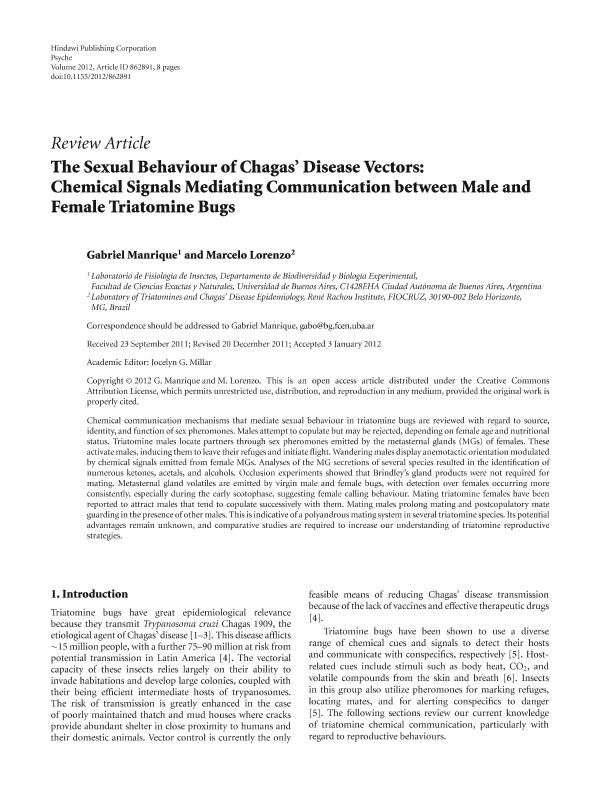Mostrar el registro sencillo del ítem
dc.contributor.author
Manrique, Gabriel

dc.contributor.author
Lorenzo, Marcelo
dc.date.available
2019-01-18T17:52:08Z
dc.date.issued
2012-01
dc.identifier.citation
Manrique, Gabriel; Lorenzo, Marcelo; The sexual behaviour of chagas' disease vectors: Chemical signals mediating communication between male and female triatomine bugs; Hindawi Publishing Corporation; Psyche; 2012; 1-2012; 1-8; 862891
dc.identifier.issn
0033-2615
dc.identifier.uri
http://hdl.handle.net/11336/68256
dc.description.abstract
Chemical communication mechanisms that mediate sexual behaviour in triatomine bugs are reviewed with regard to source, identity, and function of sex pheromones. Males attempt to copulate but may be rejected, depending on female age and nutritional status. Triatomine males locate partners through sex pheromones emitted by the metasternal glands (MGs) of females. These activate males, inducing them to leave their refuges and initiate flight. Wandering males display anemotactic orientation modulated by chemical signals emitted from female MGs. Analyses of the MG secretions of several species resulted in the identification of numerous ketones, acetals, and alcohols. Occlusion experiments showed that Brindley's gland products were not required for mating. Metasternal gland volatiles are emitted by virgin male and female bugs, with detection over females occurring more consistently, especially during the early scotophase, suggesting female calling behaviour. Mating triatomine females have been reported to attract males that tend to copulate successively with them. Mating males prolong mating and postcopulatory mate guarding in the presence of other males. This is indicative of a polyandrous mating system in several triatomine species. Its potential advantages remain unknown, and comparative studies are required to increase our understanding of triatomine reproductive strategies.
dc.format
application/pdf
dc.language.iso
eng
dc.publisher
Hindawi Publishing Corporation

dc.rights
info:eu-repo/semantics/openAccess
dc.rights.uri
https://creativecommons.org/licenses/by/2.5/ar/
dc.subject
Triatomine
dc.subject
Reproductive Bahaviour
dc.subject
Pheromone
dc.subject
Chagas'Disease
dc.subject.classification
Otras Ciencias Biológicas

dc.subject.classification
Ciencias Biológicas

dc.subject.classification
CIENCIAS NATURALES Y EXACTAS

dc.title
The sexual behaviour of chagas' disease vectors: Chemical signals mediating communication between male and female triatomine bugs
dc.type
info:eu-repo/semantics/article
dc.type
info:ar-repo/semantics/artículo
dc.type
info:eu-repo/semantics/publishedVersion
dc.date.updated
2019-01-17T14:11:59Z
dc.identifier.eissn
1415-1138
dc.journal.volume
2012
dc.journal.pagination
1-8; 862891
dc.journal.pais
Estados Unidos

dc.description.fil
Fil: Manrique, Gabriel. Universidad de Buenos Aires. Facultad de Ciencias Exactas y Naturales. Departamento de Biodiversidad y Biología Experimental; Argentina. Consejo Nacional de Investigaciones Científicas y Técnicas; Argentina
dc.description.fil
Fil: Lorenzo, Marcelo. Fundación Oswaldo Cruz; Brasil
dc.journal.title
Psyche

dc.relation.alternativeid
info:eu-repo/semantics/altIdentifier/doi/http://dx.doi.org/10.1155/2012/862891
dc.relation.alternativeid
info:eu-repo/semantics/altIdentifier/url/https://www.hindawi.com/journals/psyche/2012/862891/
Archivos asociados
